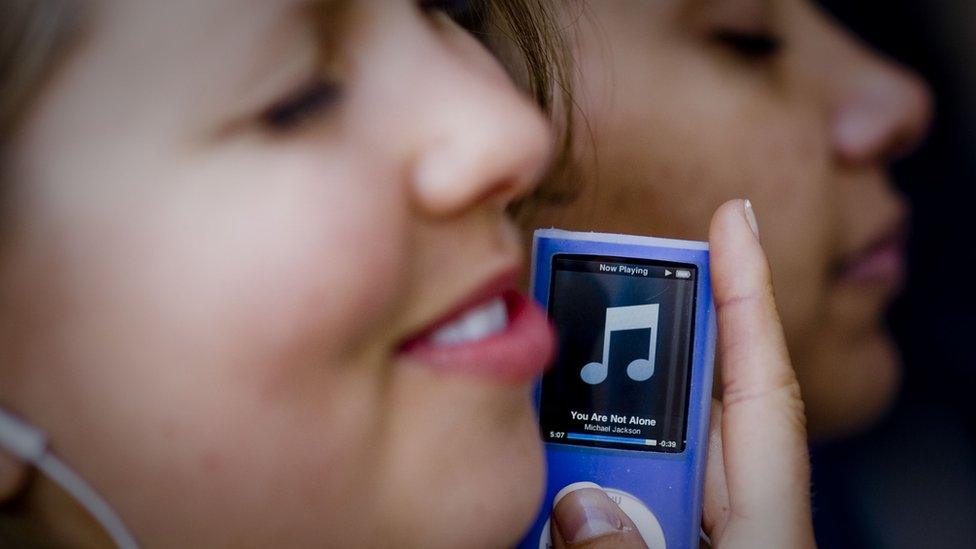It might be time to say goodbye to the MP3 - so let's look back at its life
- Published

The MP3 is officially "no more".
Well - that's according to a statement from one of the main developers of the digital audio coding format in Germany.
The Fraunhofer Institute says it has "terminated" its licensing programme with Technicolor because its patents are expiring.
MP3s led to the development of hundreds of music-listening devices, which took over from CD players, including Apple's iPod, the Sony Walkman MP3, Microsoft Zune and Samsung Galaxy Player.
The Fraunhofer Institute says the quality of the format is also inferior to its current standard.
That's called AAC - or "Advanced Audio Coding".
In a statement, external, it said: "Although there are more efficient audio codecs with advanced features available today, mp3 is still very popular amongst consumers.
"However, most state-of-the-art media services such as streaming or TV and radio broadcasting use modern ISO-MPEG codecs such as the AAC family or in the future MPEG-H.
"Those can deliver more features and a higher audio quality at much lower bitrates compared to mp3."
The supposed "death" of the MP3 won't have much of an impact because of streaming and most new portable players now use different formats anyway.
But you'll still be able to listen to the MP3s that you've ripped or bought in the past - and companies like Amazon Music, Google Play and Windows use the format.
It just means Fraunhofer/Technicolor won't be paid any more licensing fees.
Before MP3 files, we had these...
Remember CDs?
Before MP3 players, people actually had to carry round any music they wanted to listen to - often in a tatty travel case - and they weighed a tonne.
Some people still had portable cassette players as well, but the tapes kept getting eaten by the machines.
This is what a cassette looks like...
MP3s were born in Germany in 1987
This group of nerds in Germany came up with the original MP3 format, including researcher Karlheinz Brandenburg (the man holding headphones below) who's credited with inventing it.
It was developed to convert audio into digital form.
Karlheinz had been working on it since 1982.
It basically compressed music into a file size that made it easier to transmit.
This video shows the history of the MP3 format, complete with PlayMobil figures., external
But Karlheinz Brandenburg said the world almost didn't get MP3s.
"In 1991, the project almost died," he told Intel.
"During modification tests, the encoding simply did not want to work properly. Two days before submission of the first version of the MP3 codec, we found the compiler error."
Other international companies including CCETT, Matsushita, Philips, Sony, AT&T-Bell Laboratories and Thomson-Brandt also worked on the original MP3 format.
Suzanne Vega song Tom's Diner was the first song used by Karlheinz Brandenburg to develop it.
Listen to the track on YouTube., external
Warning: Third party content might contain ads
MP3s work by stripping out sounds in a song which human ears can't hear.
This is the audio that's lost when Tom's Diner is compressed for the MP3 format.
Listen to the "ghost" sounds stripped out from the song., external
Warning: Third party content might contain ads
The result was that MP3 files were around 11 times smaller than uncompressed music tracks.
But some people say the quality isn't great compared to CDs and modern file formats.
The first MP3 music service begins in 1999
The international standard for MP3s - or MPEG-2 Audio Layer-3 - was agreed in 1991.
A US patent for the format was issued in 1996 but it took companies a few years to work out how to use the new format.
The first company to distribute music tracks digitally was SubPop in 1999, but it was overshadowed by the first large peer-to-peer filesharing network, Napster, in the same year.
Shawn Fanning created Napster with Shaun Parker in 1999 after dropping out of college
Its technology allowed fans to share and swap music files on MP3 formats - for free.
But after being sued for copyright infringement - most notably by Metallica and Dr Dre - Napster had to shut down in July 2001 and went bankrupt in 2002.
Portable MP3 players first appeared in the late 90s
Despite a UK engineer patenting a Digital Audio Player way back in 1981, the first useable hardware starting appearing in 1997 and 1998.
This Aiwa MP3 player from 2004 needed an external hard disk - but at least it was small
But portable digital music players didn't become internationally popular until the launch of Apple's iPod in October 2001, just under a year after the Macintosh version of iTunes was released.
Sales didn't take off until 2004 but the company transformed the market, despite it not using the MP3 format for its music files.
Former Apple CEO Steve Jobs launched the first iPod mini in January 2004
The company launched the first iPhone in 2007, which could play tracks downloaded from iTunes.
Now all phones can play music - and do just about everything else as well.
Find us on Instagram at BBCNewsbeat, external and follow us on Snapchat, search for bbc_newsbeat, external